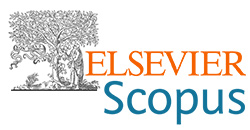The effect of anodization and subsequent treatments on corrosion resistance of aluminium
DOI:
https://doi.org/10.62638/ZasMat1174Abstract
Aluminium samples were chemically prepared by following operations: degreasing, etching I, etching II, and brightening), prior to anodizing in sulfuric acid. Aluminium surface area was 0.2 dm2. The composition of used aluminium samples was determined by the energy dispersive X-ray spectroscopy. Chemically prepared aluminium samples were electrochemically anodized for 45 minutes in a solution of 190 gdm-3 H2SO4 at room temperature, at a current density of 1.7 Adm-2. In the anodizing process, the aluminium sample served as the anode, with lead cathodes. After anodizing, the aluminium samples underwent a colouring process in five pairs of solutions (systems), where each system consisted of two solutions of inorganic salts RxA + RxB (x = 1-5, numbers of solutions). Colouring of the anodized aluminium was carried out at room temperature by immersing the samples in each solution for 7 minutes (e.g., R1A + R1B, τ = 7 min + 7 min). Each used colouring system provides a different colour: green-yellow, brown, light-grey, blue, and orange-gold. After colouring, the samples were treated in a special solution to improve corrosion resistance and silication, resulting in a change in the obtained colour shade. All obtained colours were stable with very nice appearance, allowing such coloured aluminium to be used for decorative purposes. The corrosion resistance of the coloured anodized aluminium samples was investigated by determining the corrosion potential, corrosion current and polarization resistance using potentiodynamic polarization method, as well as by electrochemical impedance spectroscopy. A common feature of all tested samples is a significant improvement in the corrosion resistance of the anodized aluminium after colouring and subsequent treatment in the corrosion resistance improvement solution, particularly after the additional silane treatment.
Keywords:
Aluminium anodization, electrochemical impedanse spectroscopy, potwntiodynamic polarization , chemical colouring, silication, corrosion resistanceReferences
R. Vračar, Ž.Živković (1993) Ekstraktivna metalurgija aluminijuma, Naučna knjiga, Beograd .
M. Antić, M. Smiljanić (2003) Aluminijum i aluminijum- ske legure, Beograd
D. Vuksanović, (2018) Uvod u metalurgiju i metale, knjiga, Podgorica
M.G. Pavlović, M.V. Tomić, Lj.J Pavlović (2005) Elec- troplating of silver onto aluminum and its alloys ̈, Jour- nal Materials Protection, 46 (2),23-27.
M. Tomić, Lj. Pavlović, M. Pavlović (2005) Direct elec- troplating of copper coatings onto aluminium, Journal Materials Protection 46(3), 13-16
Ki Beom Kim, Byung Chan Kim, Seok Jae Ha ,My- eong Woo Cho (2017) Effect of pre-treatment pol- ishing on fabrication of anodic aluminum oxide using commercial aluminum alloy, J. Mech. Sci. Technol. (31) 4387-4393
https://doi.org/10.1007/s12206-017-0838-1
M. T. Wu, I. C. Leu, M. H. Hon (2002) Effect of polish- ing pretreatment on the fabrication of ordered nanop- ore arrays on aluminum foils by anodization, JVST B (20) 775-782
https://doi.org/10.1116/1.1467657
M. Michalska-Domańska et al. (2015) Fabrication of super slippery sheet-layered and porous anodic alu- minium oxide surfaces and its anticorrosion property, Appl. Surf. Sci., (355) 487-526
https://doi.org/10.1016/j.apsusc.2015.07.140
Craig J. Donahue, Jennifer A. Exline (2014) Anodizing and Coloring Aluminum Alloys, J. Chem. Educ. 2014, 91, 5, 711-715
https://doi.org/10.1021/ed3005598
P. Vengatesh, M. A. Kulandainathan (2015) Hierarchi- cally ordered self-lubricating superhydrophobic ano- dized aluminum surfaces with enhanced corrosion re- sistance, ACS Appl. Mater. Interfaces, (7) 1516-1526
https://doi.org/10.1021/am506568v
S. Đorđević, M. Maksimović, M.G. Pavlović, K.I. Pop- ov (2000) Galvanotehnika, Tehnička knjiga, Beograd.
M. Tomić, Lj. Pavlović, M. Pavlović, M. Stojanović, B. Milošević (2004) The effect of preparation of alumi- num surface on surface reflection, Journal Materials Protection, 45(2) 63-67
M. Tomić, M. Pavlović, Z. Rakočević, Lj. Pavlović (2004) The effect of preparation of aluminum surface on surface roughness, Journal Materials Protection 45(1),5-12
M. S. de Miera, M. Curioni, P. Skeldon, G.E. Thomp- son (2010) The behaviour of second phase particles during anodizing of aluminium alloys. Corr. Sci., 52(7), 2489-2497.
https://doi.org/10.1016/j.corsci.2010.03.029
J. Konieczny, K. Labisz, M. Polok-Rubiniec, A. Włodarczyk-Fligier (2016) Influence of aluminium al- loy anodizing and casting methods on structure and functional properties, Arch. Metall. Mater, 61(3), 1337- 1342.
https://doi.org/10.1515/amm-2016-0220
U. Donatus, G.E. Thompson, D. Elabar, T. Hashimoto, S. Morsch (2015) Features in aluminium alloy grains and their effects on anodizing and corrosion. Surf. Coat. Tech., 277, 91-98.
https://doi.org/10.1016/j.surfcoat.2015.07.034
M. Shahzad, M. Chaussumier, R. Chieragatti, C. Ma- bru, F. Rezai-Aria (2010) Influence of anodizing pro- cess on fatigue life of machined aluminium alloy. Pro- cedia Eng, 2(1), 1015-1024.
https://doi.org/10.1016/j.proeng.2010.03.110
P.B. Madakson, I.A. Malik, S.K. Laminu, I.G. Bashir (2012) Effect of anodization on the corrosion behavior of aluminium alloy in HCl acid and NaOH, Int. J. Mater. Eng., 2(4), 38-42.
https://doi.org/10.5923/j.ijme.20120204.02
YA. V. Vainep, М. А. Dasoya (1972) Тehnologiya Ele- ktrokhimicheskih Pokryti, Leningrad.







